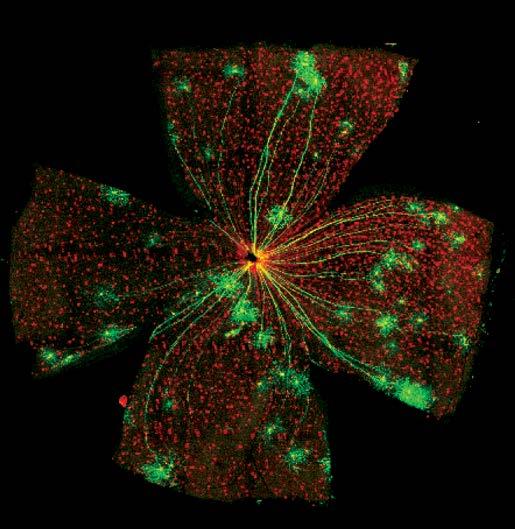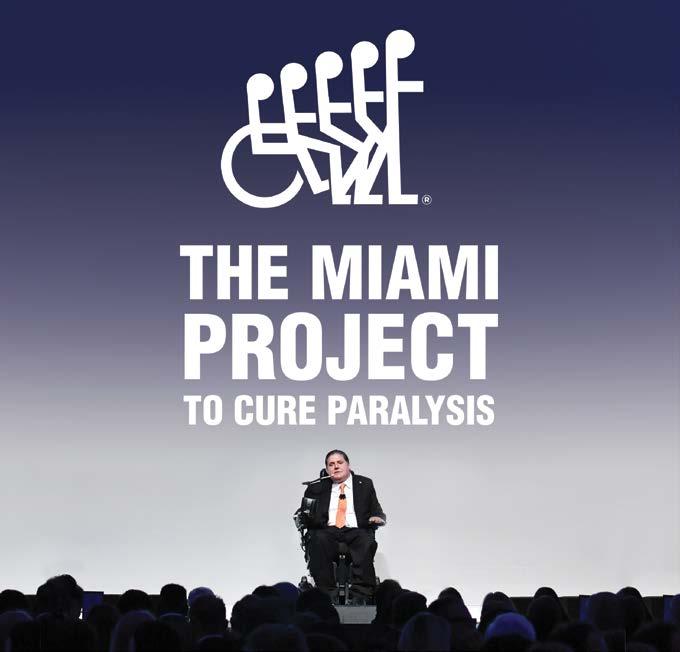
19 minute read
MESSAGES
This year marks our 36th year for The Miami Project to Cure Paralysis. Despite the many challenges, The Miami Project has thrived with steady research advancements and novel clinical programs, all of which continue to change people’s lives.
Under the leadership of Scientific Director, Dr. Dalton Dietrich and Co-Founder Dr. Barth Green, The Miami Project researchers have made some of the most incredible groundbreaking discoveries. Our basic research programs have been so successful that we have translated multiple research studies into clinical trials that are changing people’s lives now. And yes, paralyzed people are walking again and gaining more function every day. That’s what The Miami Project is about, improving the quality of life of all spinal cord and brain injured people as we search for the cures that will change their diagnosis.
But it’s beyond that also. The Miami Project research has significant implications for many other neurological injuries, diseases and disorders, including Parkinson’s, Alzheimer’s, MS, ALS and other neurodegenerative issues. The Miami Project has changed the lives of so many, and we are just getting started. Thanks to the amazing Christine E. Lynn, the doors of the new Christine E. Lynn Rehabilitation Center for The Miami Project to Cure Paralysis at UHealth/Jackson Memorial are now open, and it is one of the of the premier rehabilitation institutions in the world. It is the first center that combines traditional rehabilitation with The Miami Project’s clinical research programs, allowing patients the opportunity to maximize their potential. Every rehab patient now has access to multiple clinical studies and trials all under one roof. Never before has there been a place that offers this level of availability to care and research, from the moment of injury to the moment of discharge and beyond. The best trauma center in the world, the best patient care in the world, in the best rehabilitation center in the world, and The Miami Project is at the center of it all. The entire team is focused on delivering on my dad’s promise that we will find a cure for paralysis.
I remember the day that I lay paralyzed on the football field fighting for my life. I never thought it would lead us to this moment of enormous excitement, because now I believe that cures are just over the horizon. I think my dad would be so proud of everything that we have been able to accomplish. Not a day goes by that I don’t think about the last moments I spent with him. He looked me in the eyes and made me promise never to give up until a cure is found. Let’s continue his legacy. Join hands with me, Dr. Green, Dr. Dietrich and everyone who is part of this amazing journey of discovery. Let’s finish the job and fulfill his promise!
Marc A. Buoniconti
President, The Buoniconti Fund and The Miami Project
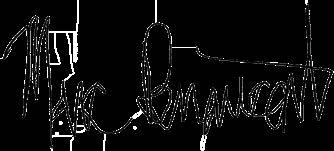
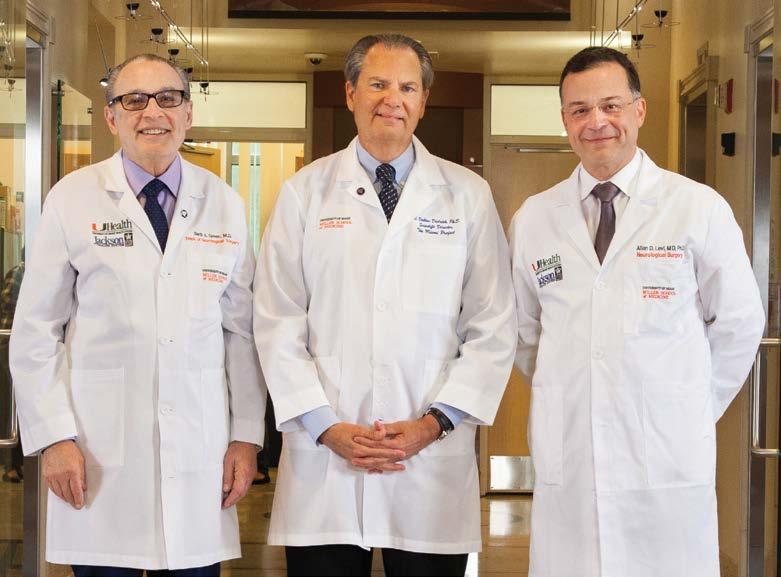
Drs. Barth A. Green, W. Dalton Dietrich, and Allan D. Levi
The Miami Project family would like to first thank all our friends, volunteers, and the spinal cord injury (SCI) community for their unwavering support for our multidisciplinary programs as we continue to advance our research initiatives. This year has presented challenges for all of us that had to be overcome to ensure our community’s safety while remaining true to our research and education objectives. We know that COVID-19 has had serious consequences on many of our friends and loved ones. We send our best wishes while looking forward to a future of exciting discoveries, successful translational programs, and meaningful clinical advances.
Over the last year, The Miami Project to Cure Paralysis, a Center of Excellence at the University of Miami Miller School of Medicine, has modified many of our education, outreach, and research clinical programs to ensure their continued success. Our investigators have initiated several remote programs for our SCI community allowing many individuals to stay connected with researchers and colleagues. Successful home programs now include exercise and rehabilitation activities as well as innovative wellness and mindfulness initiatives. These well attended programs have allowed research subjects to participate in new clinical initiatives while adhering to safety guidelines important during these challenging times. With the appreciated vulnerability of our SCI community to infections, new initiatives are safeguarding our research programs and ensuring the safety of volunteers and investigators. Information on these active remote programs and how people can register can be found on The Miami Project website. An important goal of our research strategic plan is the continued recruitment of outstanding researchers to introduce new questions and technologies that compliment current programs and advance our science. Over the last several months we have successfully recruited new faculty to lead our education and outreach program and to introduce novel neural engineering devices to activate neural circuits to promote function and improve quality of life. We are actively recruiting a new clinical investigator with expertise in SCI neuromodulation that can be combined with ongoing rehabilitation and regenerative approaches including our FDA-regulated cellular therapies. We are excited about these recruits and future contributions leading to important collaborations and innovative programs critical for our future success.
In the area of discovery and translational research, significant advances in drug discovery have been realized including new NIH funding to support an innovative pharmacological approach for promoting successful axonal regeneration after SCI. Another important program being advanced with industry assistance is a humanized antibody treatment that targets neuroinflammation after brain and spinal cord injury. New findings regarding the pathophysiology of brain and SCI are also helping us design better studies to target injury and reparative mechanisms using molecular methods, gene therapies and novel engineering approaches like tissue engineering.
Our ultimate vision is to develop successful treatments and therapies that can be administered at different phases of the injury process that complement each other to maximize protective and reparative mechanisms. Important research programs also continue to target quality of life issues that impact our SCI community, including neuropathic pain, cardiovascular and autonomic dysfunction, muscle spasticity, and fertility. To advance these initiatives, we are strengthening alliances with industry partners to evaluate new minimally invasive electrical and magnetic neuromodulation technologies, including brain-computer interface work to promote upper and lower limb function.
This is an exciting time for The Miami Project as we have now relocated our clinical researchers into the new Christine E. Lynn Rehabilitation Center for The Miami Project to Cure Paralysis. This state-of-the-art facility is already providing endless opportunities for the advancement of new strategies to improve recovery and longterm health for our disability community and caregivers. The Lynn Center is offering the unique opportunity for our clinical investigators to work together with colleagues in Physical Medicine and Rehabilitation, Physical Therapy, and Jackson Memorial Hospital. These new alliances are providing a seamless treatment pipeline from the emergency and intensive care units to rehabilitation programs to improve the long-term health and well-being of our constituents. The new Nick Buoniconti Translational Research initiative is supporting an established clinical infrastructure to ensure the success and continuation of this forward-thinking project. An overreaching goal of The Miami Project is to conduct translational research enabling future clinical advancements for neurological disorders including spinal cord and traumatic brain injury, concussion, stroke and neurodegenerative disorders including Alzheimer’s disease affecting millions of victims worldwide. Our research communities in the Lois Pope LIFE Center and the Christine E. Lynn Rehabilitation Center are working tirelessly to advance new scientific discoveries. We sincerely appreciate your critical support for the development and initiation of multidisciplinary programs to promote recovery and the quality of life of all individuals living with paralysis.
Barth A. Green, M.D., F.A.C.S - Co-Founder
W. Dalton Dietrich, Ph.D. - Scientific Director
Allan D. Levi, M.D., Ph.D. F.A.C.S - Clinical Director
The
Project
A Publication of The Miami Project to Cure Paralysis & The Buoniconti Fund to Cure Paralysis
Barth A. Green, M.D.
Chairman and Founder, The Miami Project
Marc A. Buoniconti
President, The Miami Project and The Buoniconti Fund
W. Dalton Dietrich, III, Ph.D.
Scientific Director, The Miami Project John Fox, Executive Director
David McMillan, Ph.D., Director, Education Diana Berning, Senior Manager of Business Operations Randy Carlson, Center Administrator Scott Roy, Director, Public Relations & Communications Teri Bendell, Director, Web Services, Auction and Database Management Randy Medenwald, Director, Government Relations
David McMillan, Ph.D., Editor Scott Roy, Managing Editor Robert Camarena, Graphic Editor
Contributors: Marc Buoniconti, David McMilian, Dalton Dietrich,Teri Bendell, Dr. Nancy Brackett, Robert Camarena, Randy Medenwald, Scott Roy
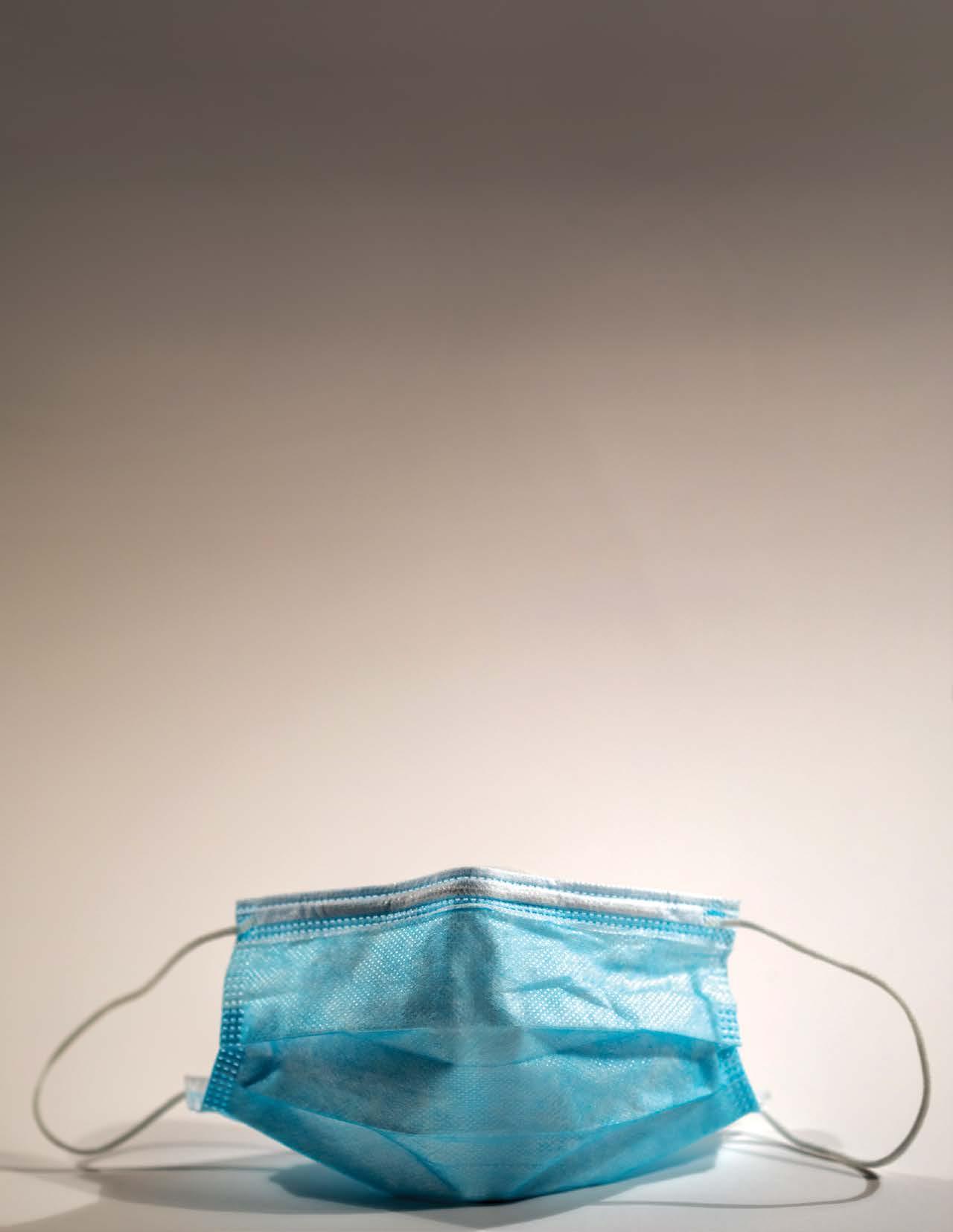
Photographs
Robert Camarena, Getty Images, Poker4Life, Dr. Nancy Brackett, Ralph Notaro, Palermo family
Physical Address: 1095 NW 14th Terrace, R-48 Miami, FL 33136 Phone: 305-243-6001
www.TheMiamiProject.org
The Project is published twice a year by The Miami Project to Cure Paralysis, a Center of Excellence at the University of Miami Leonard M. Miller School of Medicine. All contents ©2022 Reproduction in whole or in part without written permission is prohibited. The University of Miami is an Equal Opportunity/Affirmative Action Employer.Privacy Policy: If you do not wish to receive The Project in the future, please send your request to the address above or call 305-243-7147.
2 MESSAGES
Messages from Marc Buoniconti, Drs. Barth A. Green, W. Dalton Dietrich and Allan D. Levi
8 RESEARCH
KiDZ Neuroscience, Optic nerve axonal regeneration, SCI Model Systems renewal
11 FACULTY
Drs. McMillan and Ganzer join The Miami Project Faculty
18 REHABILITATION
24 EVENTS
36th Annual Great Sports Legends Dinner, Jack Nicklaus Celebrity Golf Invitational, Poker4Life, Ricky Palermo Golf Tournament, Kevin Kitchnefsky Golf Tournament
32 CHAPTERS
Miami, Indianapolis, Charleston, Naples local chapter events Darrell Gwynn Quality of Life Chapter of The Buoniconti Fund
38 MEMORIAM
In Honor of our friends Robin and Brian Cleary

BikeSafe co-founder, Dr. Mickey Witte, assists young riders with balancing on a pop-up, low-cost demonstration bike lane created by the program. The wheelchair-accessible parking zone was recreated on the other side of the street during the event.
Prevention and collaboration are at the core of the KiDZ Neuroscience Center, a youth-focused branch of The Miami Project to Cure Paralysis headed by Gillian Z. Hotz, Ph.D. and dedicated to reducing the number of children and adolescents that sustain brain and spinal cord injuries. KiDZ is now a Miami Project staple, launched in 2001 and since establishing and sustaining partnerships with Miami-Dade Public Schools, City of Miami Parks, the Miami Dolphins Foundation, and seemingly countless other community organizations in the South-East Florida region and beyond. In accordance with our ethos and historical precedent, KiDZ has continued to adapt to recent trends and expand in response to circumstance, as well as vision. Prevention means intervening when and where it matters most, and the KiDZ Neuroscience Center’s WalkSafe and BikeSafe programs have for years been delivering interventions at the earliest possible point. Targeting children—as well as their families and communities—these programs have a rich history of bringing street, crosswalk, bicycle, and helmet education to the youth in their natural environment. Continuing to meet them where they’re at, KiDZ has recently added SkateSafe to their list of programming in response to a surge of skateboarding interest likely ushered in by the recent Olympics. The 2020 Tokyo Games were the first to include stakeboarding as an event, with mandatory helmet regulations for the popular under-18 competitors. Not only has KiDZ continued to cater to the community by adapting to the rising demand of skateboarding, but the programming

Skateboard Supercross (SBSX) founder, Jonathan Strauss, with SkateSafe Skateguard Luca Guarella. A volunteer from SBSX tests the track after painting.
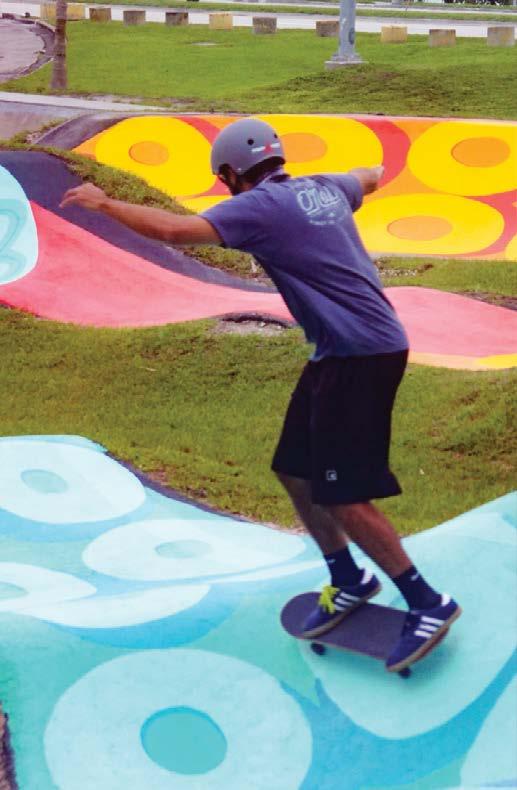
is also delivered on site at skateparks. Haulover Beach Park Stake Park and Pump Track, located at 10801 Collins Ave, is a local’s-favorite series of undulations and embankments expertly crafted into a flowing asphalt playground by Jonathan Strauss of Skateboard Supercross fame. In a mural to match, local artist Reinaldo (“Rey”) Jaffet interwove the winding course with a writhe of octopus tentacles that carry subtle neuroscience messaging and a helmeting call-to-action.
While responding to demand is a staple of participatory research, many KiDZ programs are also proactive. At Haulover, KiDZ has helped outfit the park with a volunteer “skateguard” (a homage to Miami’s lifeguards). In the community, they are pushing for safer streets as a more fundamental preventative measure than the street safety that they have been educating for so long. “It’s no longer just about teaching users to be safe on dangerous roads,” says Kurt Kaminer, KiDZ Social Marketing Manager and all-around transportation guru, “it’s about realizing how roads can be safely designed for all users.” Mr. Kaminer’s message deeply summarizes the preventative and collaborative themes that are exemplified in KiDZ and run throughout the whole of The Miami Project. We hope you were able to catch WalkSafe’s notorious “Halloween tips” flyer that is seasonally released during that one day when the streets are reclaimed by the people, and cars are simply the guests. Just as the holidays are a use-case evoking community efforts in neurotrauma prevention, so too is KiDZ Neuroscience Program a model for the interdisciplinary and visionary ethos of The Miami Project.
On August 31st, 2021 the University of Miami’s robust community of spinal cord injury (SCI) researchers and clinicians received word that they would continue for another five-year funding cycle as an exclusive SCI Model Systems (SCIMS) Center.
The grant, from the National Institute on Disability, Independent Living, and Rehabilitation Research (NIDILRR), was awarded to principal investigator (PI) Dr. Elizabeth Felix in the Department of Physical Medicine and Rehabilitation.
The Model Systems is a network of select sites known as Centers. The original overarching “Model SCI Program” was established in 1970, evolving over the years to be called SCIMS and adopt the current role of supporting innovative projects and research in the delivery, demonstration, and evaluation of diverse services for persons with SCI. The program operates primarily by funding SCIMS Center grants, such as Dr. Felix’s 2021 award, to the nation’s foremost SCI institutions. Funding only comes to sites at the leading edge of medical research and patient care, emphasizing a comprehensive care pipeline beginning at the point of injury and continuing through rehabilitation and re-entry into full community life. Designation is a mark of distinction as each SCIMS Center is held to the highest standards of SCI-specialty research and service provision. Accordingly, in this cycle only fourteen sites made the cut. Miami first became a Center in 1979, and has contributed since with some gaps. Undoubtedly, the immense potential afforded by the new Christine E. Lynn Rehabilitation Center strengthens this cycle’s application allowing us to continue our current streak of Model Systems participation. Along with the distinction, designation come with two main responsibilities. Each Center contributes standardized outcomes to a central SCIMS data repository that feeds the National Spinal Cord Injury Statistical Center (NSCISC). The mandatory requirement for database contribution is one of the reasons for the high standards for Center selection: sites must enter the Model System with their ducks already in a row. But responsibilities also extend to charting new frontiers via participation in site-specific research studies.
The site-specific studies here at our “South Florida” SCIMS Center are headed by PI Dr. Felix, with the ever-experienced Drs. David Gater and Mark Nash serving as “Co-PI” leadership. Support on the research projects will further come from likes of faculty such as Drs. Eva Widerstrom-Noga and David McMillan and postdoctoral fellow Dr. Gary Farkas. Along with the assigned outcomes for the national database, our site will pursue an ambitious project that aims to determine the links between pain, inflammation, and obesity in persons with SCI. The project will track changes in pain, the expertise of Drs. Felix and WiderstromNoga, alongside changes in inflammatory biomarkers circulating in the blood. In anticipation of the potential causes of the inflammation, body scans for the fat and muscle content of specific regions—such as the “viscera” (the stomach area) and atrophied legs—under the expertise of Drs. Gater and Farkas. Finally, a population-specific meal challenge, developed for Dr. McMillan’s dissertation under the supervision of Dr. Nash, will shed light on whether the inappropriate handling of dietary fats drives the obesity-induced inflammation that might be triggering pain in those with SCI.
Meet the New Miami Project Faculty
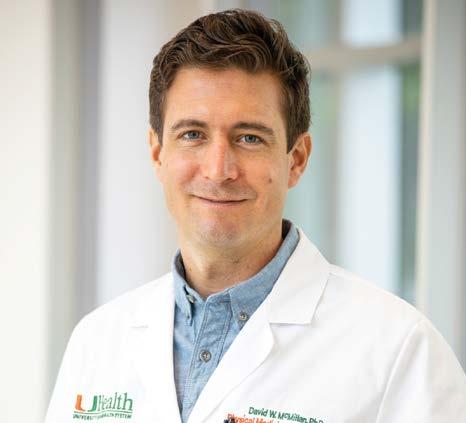
David W. McMillan, Ph.D. Patrick D. Ganzer, Ph.D.

David W. McMillan, Ph.D. has been a Miami Project researcher since 2015, and now elevates his contributions by moving into his role as the new Director of Education and Outreach. Dr. McMillan continues his personal clinical research endeavors on the dietary origins of obesity in persons with spinal cord injury (SCI). He is excited to expend this line of inquiry in concert with the world-leading SCI metabolism experts— Drs. Mark Nash, David Gater, and Gary Farkas in particular—conducting human studies in the new Christine E. Lynn Rehabilitation Center. Dr. McMillan is also deeply committed to uniting The Miami Project with the community, a relationship that will be formalized with an initiative he put forth to construct a “scientific advisory” council comprised of persons with SCI. This council is modeled on his successful community research partnership on a “climate health” project that unites all three University of Miami campuses— Main (Coral Gables), Medical, and Marine (RSMAS)—with community partners to understand hurricane preparedness in South-East Floridians living with SCI. The council is being built in collaboration with the presidents of local SCI Support Group (SCISG) chapters. Patrick D. Ganzer, Ph.D. has joined the team jointly appointed at The Miami Project to Cure Paralysis and University of Miami’s Department of Biomedical Engineering. Dr. Ganzer brings his expertise in translational neurotechnologies, coming to us after a 20172021 position in the Medical Devices and Neuromodulation division of Battelle where he was the principle investigator (PI) of the Bioelectronic Medicine and Next-Generation Nonsurgical Neurotechnology (N3) programs, the latter funded by the Defense Advanced Research Projects Agency (DARPA). Dr. Ganzer’s expertise with hardware and software development, including artificial intelligence applied to machine learning, has exiting applications across the full spectrum of research being conducted at The Miami Project. As such he is already busy collaborating with Miami Project faculty on basic-science and clinical studies while establishing his laboratory.
The Link Between Optic and Spinal Nerves
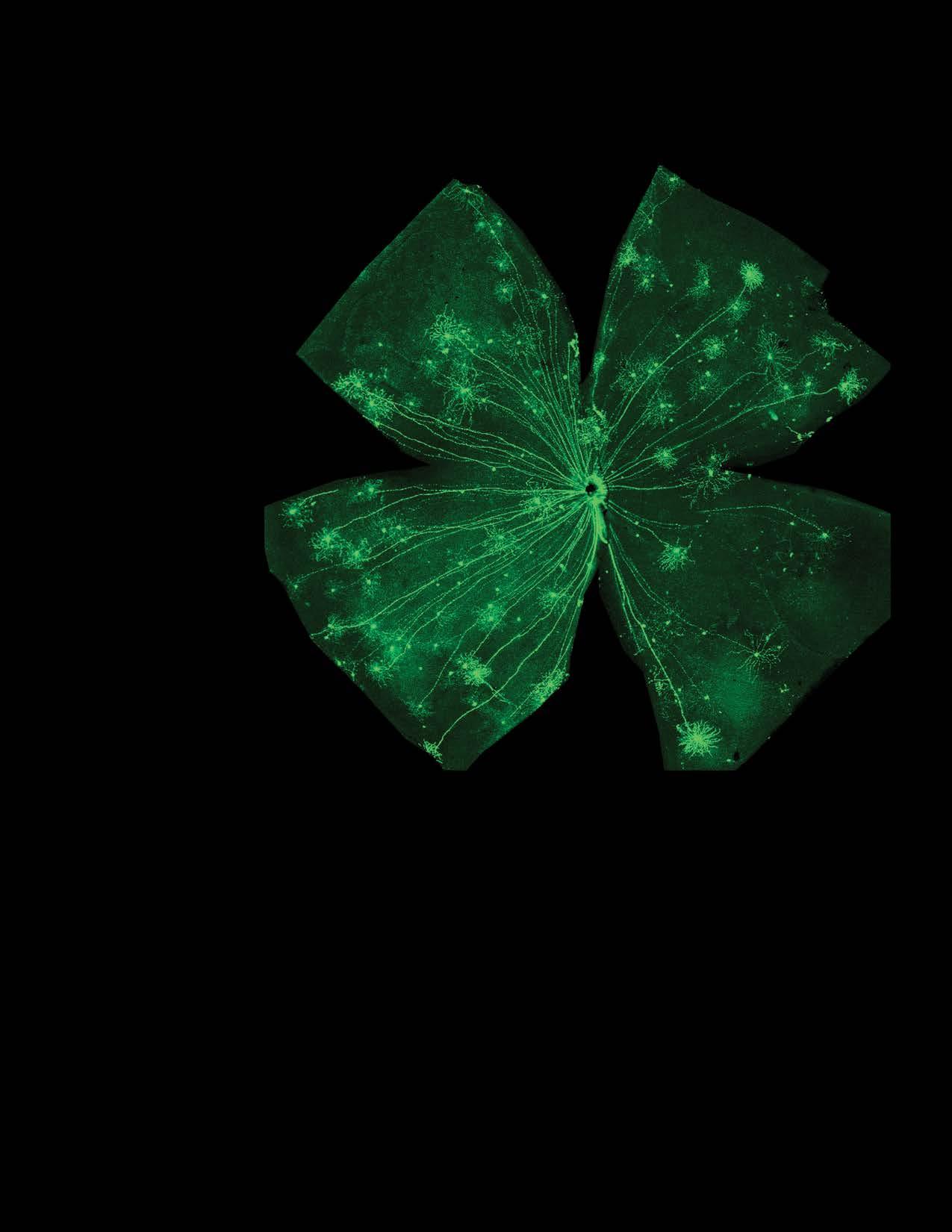
Above: Retinal whole mount preparation allowing for longitudinal perspective of axonal regeneration. Opposite page: Stained images of regenerated primary retinal neurons (green) and supporting cellular environment (red).
Dr. Kevin Park continues to look into different parts of the the central nervous system (CNS) to shed light on how the obstinate signal conducting neurons encased in our skeleton differ from those in the peripheral nervous system (PNS) nerves that project outside of our skulls and spines. Dr. Park’s research program aims to learn about CNS regeneration by studying optic nerve (“retinal ganglion cells”) injury and regeneration, and his efforts are endorsed by two new National Institute of Health (NIH) grants.
The link between optic and spinal nerves might seem illusive at first, but start by considering the almost inseparable bond between vision and movement. No plants have eyes, and within animals it is a general rule that acuity of vision is proportional to speed of movement—take for instance the Peregrine falcon’s >200 mi/hr top speed and legendary vision, or the Mantis shrimp’s “world’s fastest punch” and immensely complex eyes to match. Furthermore, despite difference in our perceived experience of vision and movement there are certain surprising similarities between the kinds of nerves that originate from within the skull and spine. First, these CNS nerves are infamously resistant to regeneration, one of the reasons why CNS trauma leading to blindness and paralysis are often, at least for the time being, chronic conditions in adults. Beyond plasticity, these nerves operate best in “small-world networks” characterized by select long-distance connections that enhance efficiency at the risk of having vastly separated the signal from its target should the connection be lost. Furthermore, the similarities between CNS neurons extend beyond the signal conducting cells themselves. All nerves, both CNS and PNS, are embedded in a matrix of support cells known as glia. The glial cells that ensheath— or “myelinate”—optic and spinal nerves are called oligodendrocytes, while those that wrap PNS nerves are called Schwann cells. Fundamental differences between oligodendrocytes, that wrap multiple cell axons, and Schwann cells, that prefer to keep their ensheathing to one nerve at a time, is another shared characteristic between optic and spinal nerves that might make it so that breakthrough regenerative discoveries from one of these cell-types might guide regenerative therapies in many CNS nerves.
It is on this premise Dr. Park’s new NIH grants function, with their findings directly applicable to visual disease and injury but also with his optic nerves decidedly acting as a model for studying regeneration of long-distance axonal connections in the CNS writ large. Dr. Park’s first grant, an exploratory grant intended to fund high-risk/high-reward projects in the conceptual phase of development, aims to develop a rodent model of glaucoma whereby optic nerve axons are damaged by elevated intraocular pressure instead of by surgical damage of the nerve. This approach mirrors that of the “contusion vs transection” model of experimentally inducing spinal cord injury in animals, with contusion reflecting the real-world neurotrauma causing CNS paralysis in people. The second, and larger, grant is an ambitious application of a suite of cutting edge technologies to Dr. Park’s tried-and-true optic nerve model to identify regeneration-promoting factors that can be the target for novel treatment. This project combines a whole-brain imaging technique and single-cell tracing so that individual, intact optic nerve cells can be visualized in three dimensional space from origin to target. It has previously been shown that certain factors can stimulate optic nerve regeneration, but due to the long-distance projections it has not yet been possible to connect the exact signal generating nerves on one side of the injury to the targets they grow to on the regenerated side. Dr. Park’s approach will allow for one-to-one 3D identification of the regenerating optic nerves, and once these nerves are identified they can be studied to determine the type of molecular properties that drive their regenerative behavior.
